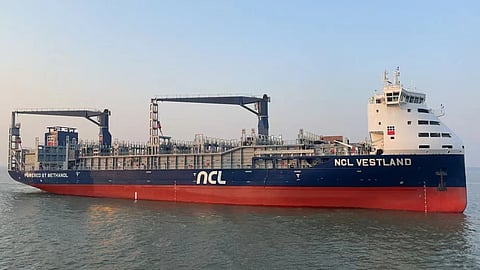VESSEL REVIEW | NCL Vestland – Methanol-fuelled containership for Norwegian coastal feeder routes
China’s Taizhou Sanfu Shipbuilding has delivered a new feeder container vessel to Norwegian operator MPC Container Ships (MPCC).
NCL Vestland is the first unit in a series of two containerships ordered by MPCC. The vessels are notable for being fitted with dual-fuel engines that can run on MGO or green methanol as a low-emission alternative.
NCL Vestland will be operated under a 15-year charter with Norwegian transport company North Sea Container Line (NCL). NCL Nordland, the second vessel in the series, is scheduled to be handed over to MPCC later in the first half of 2025. Both will sail under the Portuguese flag.
Equipped with ice class hulls, the feeder vessels will be deployed on trades along the Norwegian west coast where MPCC said they can generate up to 95 per cent fewer emissions compared to conventional ships. The project to design the new vessels was undertaken with support from the Norwegian ENOVA and NOx Funds.
The vessel has an LOA of 150 metres (490 feet), a beam of 26.8 metres (87.9 feet), a draught of 9.9 metres (32 feet), a deadweight of 18,800, a design speed of 18 knots, and a capacity of 1,300 TEUs including up to 380 reefer containers and containers laden with IMDG-compliant dangerous goods.
The total container capacity is around 40 per cent greater than those of other vessels currently operating on the same feeder routes along the Norwegian coastline.
Streamlined hull design coupled with flexible cargo-carrying capability
The ship is also notable for having its superstructure placed well forward near the bow to provide significantly improved visibility from the bridge even when transporting a full load of containers. The layout also permits control of the ship by only one crewmember on the bridge if needed, and trials have proven this configuration to also be effective when navigating in narrow channels on coastal routes.
The hull boasts an optimised design and energy-saving features such as a twisted flap rudder and a rudder ball. The bow is fitted with a shroud, which not only improves the ship’s appearance but also reduces wind resistance while underway.
The container carrying layout features detachable guide rails in the cargo hold to permit loading containers of anywhere between 20 and 45 feet (between six and 14 metres) in length, thus enabling the vessel to serve a greater number of European feeder customers. The guide rails are set up high to reduce both the lashing workload and the crew load.
The cargo hold adopts a hatchless cover design, which eliminates the need for opening and closing hatch covers during frequent calls at and departures from multiple ports, thus reducing berthing times. The design also permits centralised loading and unloading of goods at the same wharf with no need to rotate each container, therefore improving loading efficiency.
Offering significantly lower emissions
Because the ship is also fitted with two 45-tonne cranes, it will be able to operate independently of loading land-based infrastructure, providing more flexibility regarding what ports may be visited. NCL said this sea-based infrastructure enhances the company’s operational efficiency and contributes to significant savings in land-based infrastructure investments.
The propulsion setup includes one MAN 6S50ME-C9.6-LGIM-EcoEGR engine driving a controllable-pitch propeller and an energy storage system with shore power charging capability to help further reduce emissions while at berth.
The use of methanol fuel will help achieve a 63 per cent reduction in energy consumption per TEU per nautical mile in addition to satisfying IMO Tier III NOx emissions requirements.
An integrated energy management system will meanwhile be used for peak shaving to stabilise power flow.
Design work on the new MPCC feeder ship series was undertaken by China’s Shanghai Merchant Ship Design and Research Institute (SDARI) in compliance with DNV class rules. The vessels will replace three of NCL’s earlier, lower-capacity diesel-powered feeder ships in partial fulfilment of the company’s goal of achieving 80 per cent fewer CO2 emissions by 2030.


